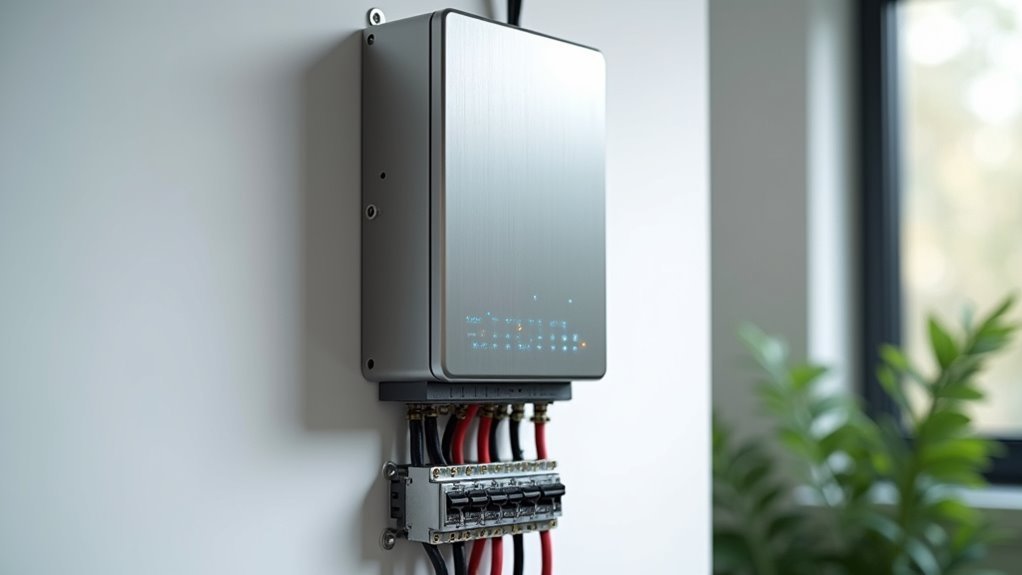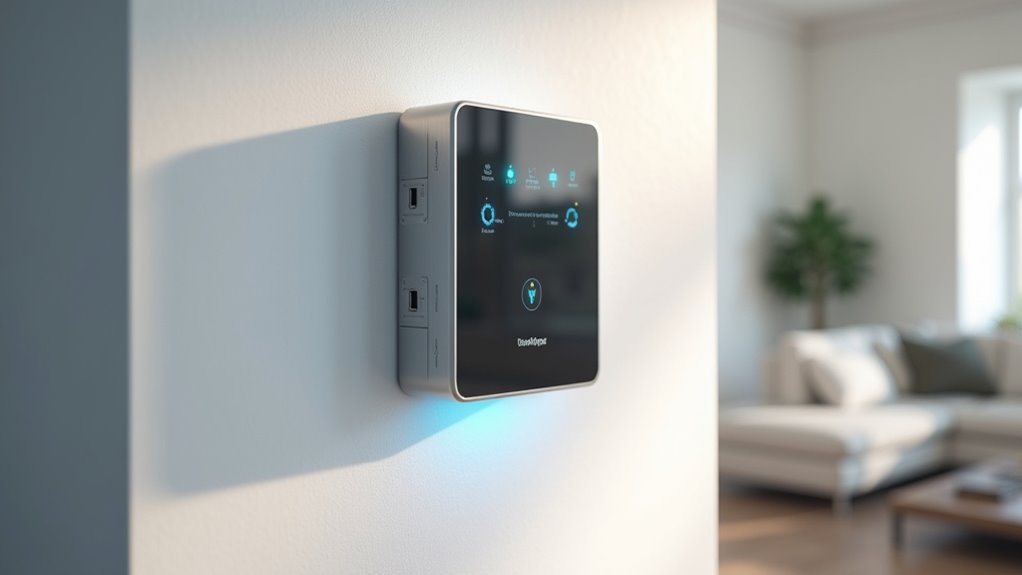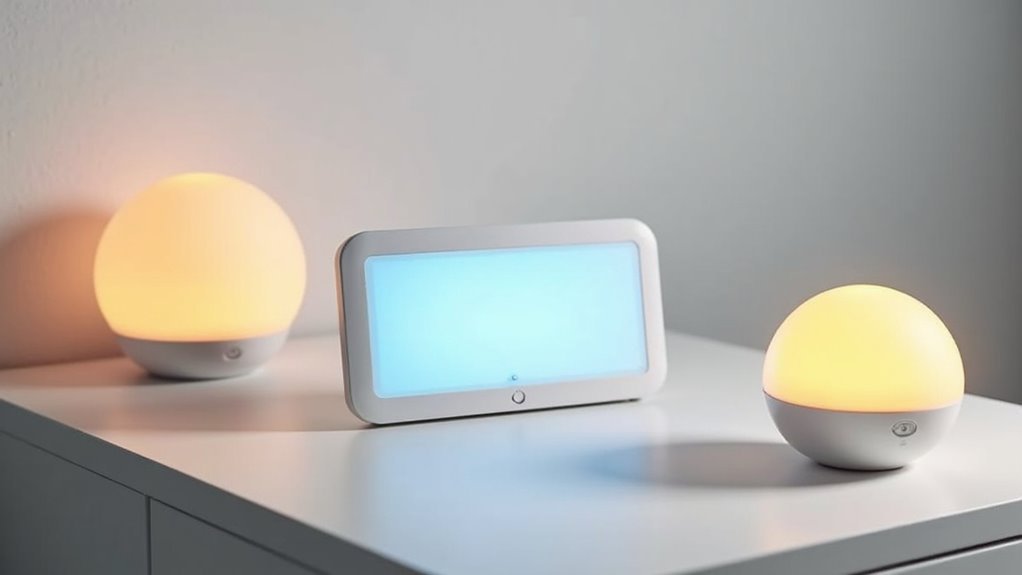You’re paying more for electricity than you need to, and your home’s energy consumption is likely spiraling out of control without you realizing it. Energy-efficient hubs can slash your monthly bills by up to 30% while giving you unprecedented control over every device in your house. These intelligent systems don’t just monitor your usage—they learn your habits and automatically optimize everything from heating to lighting. But choosing the wrong hub could cost you thousands.
What Are Energy-Efficient Hubs and How Do They Work

Energy-efficient hubs act as the brain of your smart home, centralizing control over various devices and appliances to optimize your household’s energy consumption.
These sophisticated systems monitor your energy patterns continuously, helping you identify inefficiencies and adjust usage accordingly. You’ll achieve significant energy savings, potentially reducing bills by 10-30%.
The hub integrates seamlessly with your smart devices, from thermostats to lighting systems.
Using advanced algorithms, it automatically adjusts heating, cooling, and lighting based on occupancy and time schedules. This creates an energy-efficient home that responds intelligently to your daily routines.
You’ll receive real-time data and alerts about your energy consumption, empowering informed decisions.
The system works particularly well with renewable sources like solar panels, maximizing green energy usage while minimizing grid dependence.
Key Benefits of Installing a Smart Energy Management Hub
Installing a smart energy management hub transforms your home into an intelligent system that delivers measurable financial and environmental benefits.
You’ll reduce energy consumption by 10-30% through real-time monitoring and automated scheduling that minimizes usage during peak demand periods. Your smart home becomes more efficient as the hub identifies consumption patterns, helping you make informed decisions about energy use.
The system’s compatibility with renewable sources like solar panels enhances overall energy efficiency while reducing grid dependence.
You’ll gain valuable insights into consumption trends, enabling you to set realistic energy-saving goals and track progress.
Remote appliance control and automated features guarantee ideal energy management even when you’re away, maximizing savings and environmental impact.
Essential Features to Look for in Energy-Efficient Hubs

When selecting a smart energy management hub, you’ll want to prioritize devices that excel at multi-device integration, allowing you to centrally control everything from energy-efficient appliances and smart thermostats to automated lighting systems.
Energy-efficient hubs should support communication protocols like Zigbee or Z-Wave for seamless connectivity with various smart devices while minimizing power consumption.
Modern smart energy hubs utilize Zigbee and Z-Wave protocols to ensure reliable device communication while maintaining optimal power efficiency.
Here are three essential features to prioritize:
- Advanced scheduling capabilities – These let you automate energy use by programming lights and appliances to turn off during peak electricity rate hours.
- Real-time energy monitoring – Provides instant insights into consumption patterns, helping you identify additional saving opportunities.
- Renewable energy compatibility – Guarantees integration with solar panels and other green energy systems.
These features maximize your hub’s efficiency while reducing reliance on traditional power sources.
Top Smart Devices That Connect to Your Energy Hub
Your energy hub becomes truly powerful when you connect the right smart devices that work together to slash your utility bills.
Smart thermostats lead the charge by automatically optimizing your heating and cooling based on your daily routines, while energy monitoring devices give you real-time insights into which appliances are draining your wallet.
Automated water controls round out this energy-saving trio by preventing waste through intelligent leak detection and weather-based irrigation scheduling.
Smart Thermostat Integration
Although smart thermostats represent one of the most popular entry points into home automation, their true potential emerges when they’re connected to your energy hub for extensive climate control.
Unlike a basic programmable thermostat, smart thermostats learn your preferences and automatically optimize settings to reduce your energy consumption by 10-30%.
When integrated with your energy hub, these devices provide three key advantages:
- Real-time weather adaptation – Automatically adjusts indoor temperatures based on changing outdoor conditions
- Comprehensive energy usage insights – Tracks heating and cooling patterns to identify optimization opportunities
- Remote smartphone control – Prevents energy waste by allowing adjustments from anywhere
Popular models like Google Nest Learning Thermostat and Ecobee Smart Thermostat seamlessly connect with other smart devices, creating a unified system that maximizes efficiency while maintaining comfort.
Energy Monitoring Devices
While smart thermostats optimize your climate control, energy monitoring devices take your home’s efficiency to the next level by revealing exactly where and when you’re consuming power.
These smart home devices provide real-time insights into your household energy use, helping you identify patterns and achieve energy savings of 10-30% on monthly bills.
You’ll receive detailed data on individual appliance consumption, pinpointing which devices drain the most electricity.
Advanced features include historical analysis and alerts for unusual energy spikes, letting you catch inefficiencies early.
Many energy monitoring devices integrate seamlessly with your smart home hub, enabling centralized control and automation.
You can even participate in demand response programs, earning incentives for reducing consumption during peak times while maximizing your overall energy savings.
Automated Water Controls
Beyond monitoring your electricity usage, automated water controls represent another powerful category of smart devices that dramatically reduce both water waste and the energy required to heat it.
These intelligent systems optimize your home’s water consumption while enhancing overall energy efficiency.
Key automated water controls include:
- Smart sprinkler systems that adjust irrigation schedules using real-time weather data, preventing unnecessary watering.
- Automatic shut-off valves that stop water flow during detected leaks, especially when you’re away.
- Leak detection sensors that send instant text or email alerts about potential water damage.
Setting Up Your DIY Smart Home Energy Management System
Since smart home technology has become more accessible and affordable, you can now create an effective energy management system without hiring professionals or investing thousands of dollars.
Begin with a smart thermostat that can slash your heating and cooling costs by 10-30% through proper programming. Install smart power strips throughout your home to eliminate standby power waste, reducing energy consumption by up to 30%.
Replace existing fixtures with smart LED light bulbs, which use 75% less energy than incandescent bulbs while lasting 25 times longer. Conduct an energy audit to identify inefficiencies, then add smart leak detectors to prevent water heater waste and smart sprinkler systems that adjust to weather data for ideal irrigation scheduling.
Optimizing Heating and Cooling Through Hub Integration

You’ll maximize your energy savings by connecting smart thermostats directly to your hub for centralized climate control throughout your home.
Smart thermostat hub controls let you monitor and adjust temperatures remotely while learning your daily routines to automatically optimize heating and cooling schedules.
Zone-based climate management takes this further by allowing you to heat or cool only occupied areas, potentially cutting your energy bills by 10-30% compared to traditional systems.
Smart Thermostat Hub Controls
When you integrate smart thermostats with your home automation hub, you’re accessing one of the most effective ways to slash your energy bills while maintaining ideal comfort.
Smart thermostat hub controls learn your routines and automatically optimize settings, delivering 10-30% savings on heating and cooling costs when configured properly.
These programmable thermostats offer three game-changing features:
- Geofencing technology adjusts temperature based on your proximity to home
- Remote access lets you control settings from anywhere to save energy
- Automatic scheduling lowers temperatures 7-10°F for 8 hours daily, cutting bills by 10% annually
Zone-Based Climate Management
Zone-based climate management transforms your home’s heating and cooling from a one-size-fits-all approach into a precision system that targets specific areas with customized temperatures.
You’ll eliminate energy waste by heating or cooling only occupied spaces, rather than maintaining uniform temperatures throughout your entire home.
When you pair smart thermostats with zone-based systems, you can achieve up to 30% energy savings on your heating and cooling bills.
These systems work seamlessly with energy recovery ventilators, recovering over 80% of energy from exhaust air while maintaining excellent indoor air quality.
You can integrate this technology with high-efficiency heat pumps for maximum performance.
Smart home controls let you monitor and adjust zones remotely, providing real-time optimization that enhances both comfort and efficiency.
Smart Lighting Control and Automated Scheduling
Since traditional lighting systems waste energy by operating continuously regardless of occupancy or natural light availability, smart lighting control transforms your home into an energy-efficient hub that responds intelligently to your daily patterns.
You’ll achieve remarkable energy savings by replacing incandescent bulbs with LED lighting that lasts 25 times longer while consuming 75% less energy.
Automated scheduling optimizes your lighting efficiency through:
- Motion sensors that illuminate rooms only when occupied, eliminating waste in empty spaces
- Timed controls that automatically turn lights on and off based on daylight hours and your routine
- Remote monitoring via home automation platforms for efficient management anywhere
You’ll reduce your annual lighting energy bills by 15-30% while enjoying enhanced convenience and control over your home’s lighting systems.
Managing Water Heating Systems With Hub Technology
Water heating systems represent one of your home’s largest energy expenses, consuming up to 18% of your total household energy usage.
But smart hub technology transforms these traditionally inefficient appliances into responsive, cost-saving devices. You’ll maximize energy conservation by programming your smart water heater to operate during off-peak hours when electricity rates drop notably.
Lowering your thermostat from 145°F to 120°F cuts energy costs by 10% while maintaining adequate hot water supply. Advanced leak detection prevents wasteful cycling that consumes over 1,000 kWh annually.
Smart temperature adjustments and leak detection technology can slash water heating costs by thousands of kilowatt-hours each year.
Your hub’s real-time usage data reveals consumption patterns, enabling you to modify habits and optimize performance. This intelligent integration turns your water heater into an efficient, money-saving component of your home’s energy management system.
Appliance Monitoring and Efficiency Tracking
Your smart hub’s monitoring capabilities extend beyond water heating to track every appliance in your home, giving you unprecedented visibility into your household’s energy consumption patterns.
Through appliance monitoring, you’ll identify energy hogs and optimize usage to slash electricity bills.
Smart plugs connected to your hub reveal standby power waste from devices you thought were “off.” Energy-efficient appliances with ENERGY STAR ratings already use 10-50% less energy than standard models, and your hub helps maximize their potential.
Here’s what thorough monitoring delivers:
- Real-time consumption data from every connected appliance and device
- Usage pattern insights that reveal optimization opportunities throughout your day
- Automatic adjustments based on your preferences and peak rate schedules
This systematic approach typically generates 10-30% energy savings, reducing both utility costs and your carbon footprint considerably.
Real-Time Energy Usage Analytics and Reporting
You’ll gain immediate visibility into your energy consumption through smart meter data insights that reveal exactly when and where you’re using the most power.
By tracking your energy consumption patterns over time, you can identify wasteful habits and optimize your usage during peak and off-peak hours.
Cost savings dashboard features transform complex energy data into clear visualizations that help you monitor your progress and calculate real savings from your efficiency efforts.
Smart Meter Data Insights
While traditional utility meters only provide monthly snapshots of energy consumption, smart meters deliver continuous, real-time data that transforms how you understand and manage your home’s energy usage.
You’ll gain access to detailed analytics through mobile apps and online dashboards, empowering informed decision-making about your household’s energy patterns.
Smart meters reveal three key advantages:
- Peak consumption identification – Pinpoint exactly when your home uses the most energy
- Dynamic pricing benefits – Adjust usage during high-demand periods to reduce costs
- Automated adjustments integration – Connect with home automation systems for optimized appliance control
The thorough reports reveal specific savings opportunities while enabling you to respond to fluctuating energy rates.
This real-time insight capability turns your smart meters into powerful tools for strategic energy management.
Energy Consumption Pattern Tracking
Because energy consumption patterns shift throughout the day, real-time analytics give you instant visibility into exactly how and when your home uses power.
You’ll spot peak usage times and adjust your schedule to capitalize on off-peak rates, potentially cutting costs considerably.
Real-time monitoring reveals consumption spikes and wasteful habits you didn’t know existed, enabling immediate corrections that can reduce your energy consumption by up to 15%.
Advanced reporting features highlight trends and anomalies, helping you make smart decisions about energy efficiency upgrades.
When you integrate smart home technology with these tracking systems, your home automatically responds to usage data—adjusting heating, cooling, and appliances for peak efficiency without requiring constant manual intervention.
Cost Savings Dashboard Features
Modern cost savings dashboards transform raw energy data into actionable financial insights that put money back in your pocket.
These sophisticated interfaces track your energy consumption patterns while highlighting exactly where you’re overspending on utilities.
Your dashboard delivers three powerful capabilities:
- Real-time monitoring – Watch your consumption and costs fluctuate throughout the day
- Appliance-specific reporting – Identify which devices drain your wallet most
- Personalized recommendations – Receive custom strategies based on your usage history
You’ll discover peak usage times and assess how well your energy-saving measures perform over time.
The dashboard’s integration with smart home devices enables automated responses to consumption spikes, maximizing your cost savings potential through intelligent energy management.
Cost Savings Potential With Energy Hub Implementation
When you implement an energy hub in your home, you’ll reveal significant cost-saving opportunities that can dramatically reduce your monthly utility expenses.
Smart device integration optimizes energy management, delivering up to 30% savings on your utility bills. You’ll save money through real-time monitoring that identifies wasteful practices, with smart thermostats alone providing $130-$180 annually.
Smart device integration delivers up to 30% utility bill savings through real-time monitoring and automated energy optimization.
Energy-efficient appliances within your hub further reduce costs. LED lighting contributes approximately $225 yearly savings per household.
You can schedule energy-intensive tasks during off-peak hours, minimizing electricity expenses through strategic automation.
The financial benefits extend beyond immediate savings. Tax credits and rebates for energy-efficient upgrades enhance your return on investment, making energy hub implementation a financially smart decision that pays dividends long-term.
Troubleshooting Common Energy Hub Installation Issues
You’ll likely encounter several common issues when installing your energy hub that can disrupt the setup process.
Wiring connection problems often stem from incompatible electrical systems or incorrect following of installation diagrams.
Device compatibility issues and network setup failures can also prevent your hub from communicating properly with your appliances and internet connection.
Wiring Connection Problems
Although energy hubs promise enhanced efficiency, faulty wiring connections can undermine their performance and create costly problems. Wiring connection problems disrupt efficient power distribution, causing energy loss and inflated utility bills.
Loose connections create intermittent power supply, increased resistance, and dangerous overheating that damages your energy systems.
To prevent these issues, focus on these critical steps:
- Follow local electrical codes – Ascertain all wiring meets safety standards and regulations for peak performance
- Use color-coded wiring – This simplifies troubleshooting and guarantees proper terminal connections during installation
- Schedule regular inspections – Routine maintenance helps detect early wear or damage before major problems develop
Proper wiring practices protect your connected devices, reduce energy waste, and maximize your energy hub’s longevity.
Don’t let poor connections sabotage your investment.
Device Compatibility Issues
Device compatibility issues can transform your promising energy hub installation into a frustrating maze of connection failures and underperforming systems.
You’ll need to verify that your smart devices use compatible communication protocols like Z-Wave, Zigbee, or Wi-Fi before connecting them to your energy efficiency hub. Different manufacturers often use varying standards, creating connectivity issues that prevent seamless integration.
Always check for firmware updates on both your hub and connected devices, as outdated software frequently causes compatibility problems.
Consider signal range and physical barriers that might weaken communication between devices. Consult user manuals for device-specific pairing instructions, since setup procedures vary considerably between brands.
Finally, test power configurations within your hub’s app to guarantee ideal energy-saving performance and prevent compatibility conflicts.
Network Setup Failures
When network configuration goes wrong, your energy hub becomes an expensive paperweight that can’t communicate with your smart devices or access cloud-based features.
You’ll face frustrating connectivity issues that prevent proper automation and monitoring of your home’s energy consumption.
To resolve network setup failures, follow these critical steps:
- Reset your energy hub and smart devices – Power cycle everything and restart the pairing process from scratch.
- Verify network settings configuration – Double-check Wi-Fi passwords, security protocols, and confirm you’re using the correct frequency band.
- Create a dedicated network – Set up a separate Wi-Fi network specifically for your energy hub to reduce congestion and improve performance.
Don’t forget to check device range limitations and make sure your hub’s positioned centrally for ideal signal distribution throughout your home.
Comparing Popular Energy Management Hub Brands
As homeowners increasingly seek smart solutions for energy management, three major brands have emerged as frontrunners in the hub marketplace: Google Nest, Samsung SmartThings, and Amazon Echo Plus.
You’ll find Google Nest excels at integration with various smart home devices, delivering 10-12% annual savings on heating and cooling costs when properly programmed.
Samsung SmartThings supports extensive device compatibility and lets you create custom automation routines that optimize energy-efficient operations based on your lifestyle.
Amazon Echo Plus combines voice control with built-in hub functionality, seamlessly connecting compatible devices.
All three platforms support ENERGY STAR appliances, ensuring you can effectively monitor and reduce consumption while maximizing your home’s energy-efficient potential through centralized control.
Future-Proofing Your Smart Home Energy System
Building a smart home energy system that’ll serve you well into the future requires strategic planning beyond today’s immediate needs.
You’ll want to invest in technologies that adapt and deliver long-term value.
Here are three essential components for future-proofing your energy system:
- Smart thermostats – These optimize heating and cooling automatically, saving you 10-12% on monthly energy bills through intelligent temperature management.
- Solar panels – Installing solar-ready designs reduces fossil fuel dependence while offsetting installation costs by up to 30% over time.
- ENERGY STAR® appliances – These qualify you for tax credits and rebates while greatly reducing energy consumption.
Don’t overlook energy-efficient power strips, which cut standby energy use by 30%.
Regular insulation and air sealing assessments can boost efficiency by another 10%.
Frequently Asked Questions
What Is the Most Efficient Method to Produce Energy and Power Your Home?
You’ll find Combined Heat and Power systems most efficient, achieving 80% efficiency by generating electricity and heat simultaneously. Solar panels work excellently in sunny regions, potentially covering 100% of your energy needs.
What Wastes the Most Energy in a House?
Your heating and cooling system wastes the most energy, consuming 47% of your home’s total usage. You’re also losing significant energy through standby power from electronics and inefficient water heating practices.
What Does Use Electricity Wisely Mean?
Using electricity wisely means you’re optimizing your energy consumption to minimize waste. You’ll reduce costs by implementing smart thermostats, switching to LED lighting, maintaining efficient appliances, and making simple adjustments throughout your home.
What Consumes the Most Power in Your Home?
Your heating and cooling system consumes the most power in your home, accounting for nearly half of your energy use. It’s the biggest contributor to your monthly electricity bills and overall energy consumption.





Leave a Reply